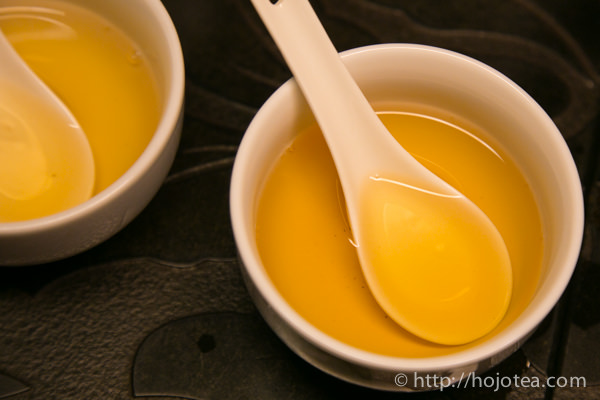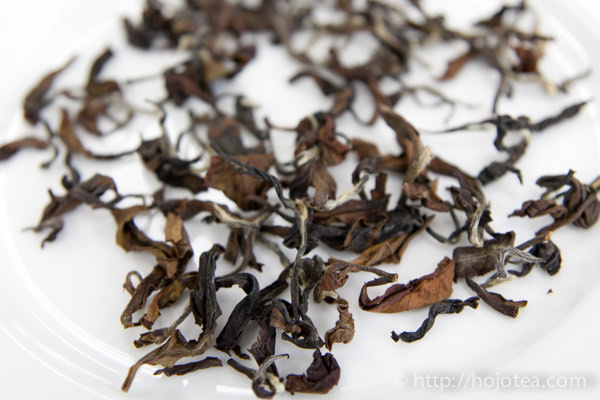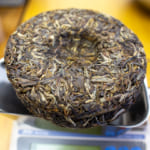- HOME >
- Tea Processing
The Green Fly that Produces the Muscatel Flavor of Oriental Beauty

Most people associate Taiwan oolong tea as a lightly fermented tea, which is often called as high mountain tea. Nevertheless, there is one distinctive oolong called Oriental Beauty, which has a completely different characteristic from other Taiwan oolong teas. The Oriental Beauty is a deeply fermented tea. If you take a look at its tea leaves, the colour is very similar to that of a black tea. Although its appearance is more like black tea, based on the sequences in tea processing the Oriental Beauty is still categorized as the oolong tea group.
Black Tea
Withering >> Rolling >> Fermentation >> Heating to stop fermentation
Oriental Beauty
Withering & Fermentation >> Heating to stop fermentation >> Rolling
Due to the sequence in the process, the Oriental Beauty is technically categorized as oolong tea.
The muscatel flavour that reminds you of Muscat wine
The main character of Oriental Beauty is its distinctive muscatel flavour. In Chinese, the flavour of Oriental Beauty is called as Mi Xiang which means honey flavour. In my opinion, the flavour of Oriental Beauty quite resembles to those late-harvested wines such as Ice Wine.
Do you know how this muscatel flavour is made?
The material being used for the Oriental Beauty itself is not the same as the rest of Taiwan high mountain oolong teas. No matter how much skill the tea master has, they cannot produce this muscatel flavour if they use ordinary tea leaves. Hence, if the farmer wishes to produce the Oriental Beauty, he has to collect a special type of tea leaves.
The Oriental Beauty is made of the tea leaves attacked by little green insects
To make this distinctive flavour of Oriental Beauty, the farmers have to collect the tea leaves that were attacked by tiny little green flies.

This insect is called the Empoasca onukiiMATSUDA and it is called 小緑葉蝉 in Chinese; sometime in Taiwan local tea farmers it is more commonly known as 小绿叶蝉. It is the tea green leafhopper, a common pest in tea garden. For most of other ordinary tea farmers, this insect is their pest; but, to produce Oriental Beauty, this insect is “precious” and essential. The tea garden must never be sprayed with any insecticide. Once the tea leaves are attacked by this insect, yellow spots will appear on the surface of the tea leaves; and, with further attack by this green insect, the tea leaves would turn as yellow as a banana skin. Thus, the growth of the tea leaves is suppressed with the intensive attack of this insect, which is why they are not welcomed in most of the ordinary tea gardens. Due to the attacks of the insects, these tea leaves will produce a substance called phytoalexin that is part of their self-defense mechanism (acts like an antibody for human). This substance (phytoalexin) is produced by plants when attacked by any pests such as insects or microorganisms. The phytoalexin of Oriental Beauty is called Terpenoid which is in a group called terpene; this substance generally gives a sweet fragrance. The terpene also exists in rose, citrus fruits and is a common substance found in various kinds of perfume. Furthermore, the main compound in insect repellents is also the various types of terpene. For example, it is said that mosquitos dislike the fragrance of lemon or lemon grass, which are also terpene. However for human, we generally are attracted to the fragrance of terpene. The terpene is produced when the self-defense mechanism of plants are triggered, protecting them against the attack of green insects. According to some researches, the substance being produced in responding to the insect attack is (3E,6S)‐2,6‐ Dimethylocta‐3,7‐diene‐2,6‐diol. This substance will be further oxidized and form hotrienol during fermentation and subsequent heating process. This would be the primary substance that contributes to the muscatel flavour of Oriental Beauty. If without the important role played by green flies, we wouldn’t be able to have had this distinctive muscatel flavour in tea.
Related Articles
How to get the latest update on HOJO?
1. Follow Twitter, 2. Click "Like" on Facebook, and 3. Subscribe in newsletter. You can have the latest tea news from HOJO.
 Subscribe the Newsletter to enjoy the privileges
Subscribe the Newsletter to enjoy the privileges- You may receive a free sample upon purchase, or you may have the priority to purchase special products. So please remember to subscribe our newsletter as well as the social network.
- New Arrival of Akitsu Mumyoi and Nosaka Rough Clay Teapot
- A wide selection of teaware by Watanabe Tozo, a Sado-based artist of Mumyoi-yaki, has just arrived. This time, …
- Mang Fei Ripe Pu-erh Tea 2023 – Small-Batch Production from a Renowned Region
- Mang Fei Ripe Pu-erh Tea 2023 is now available. This is one of the highest-quality ripe pu-erh teas among our …
NEW ARTICLES
 Development of Firewood Roasted Hojicha Using Naturally Grown Tea from Yunnan
Development of Firewood Roasted Hojicha Using Naturally Grown Tea from Yunnan- We are currently staying in Yunnan Province for tea production. As the season nears its end, tea trees with pa …
 Exploring the Food Culture of Yunnan: Where Minority and Sichuan Cuisines Meet
Exploring the Food Culture of Yunnan: Where Minority and Sichuan Cuisines Meet- We are currently staying long-term in Yunnan Province for spring tea production. On rainy days or when there i …
 New Arrival of Akitsu Mumyoi and Nosaka Rough Clay Teapot
New Arrival of Akitsu Mumyoi and Nosaka Rough Clay Teapot- A wide selection of teaware by Watanabe Tozo, a Sado-based artist of Mumyoi-yaki, has just arrived. This time, …
 Managing Yunnan White Tea — Insights from the Field
Managing Yunnan White Tea — Insights from the Field- Since March 25, we have been in Yunnan Province, fully engaged in the production of white tea. In this column, …
 Mang Fei Ripe Pu-erh Tea 2023 – Small-Batch Production from a Renowned Region
Mang Fei Ripe Pu-erh Tea 2023 – Small-Batch Production from a Renowned Region- Mang Fei Ripe Pu-erh Tea 2023 is now available. This is one of the highest-quality ripe pu-erh teas among our …
 Yunnan Tea Trends 2025: Insights from the Fields
Yunnan Tea Trends 2025: Insights from the Fields- Since March 25, we have been in Yunnan Province. We will stay here until May to conduct tea production, packin …
 Why Do Some Teas Taste Astringent? Exploring the Causes and Mechanisms of Astringency
Why Do Some Teas Taste Astringent? Exploring the Causes and Mechanisms of Astringency- Tea can range from having no noticeable astringency to possessing a very strong one. What causes this astringe …
 The Impact of Heat Sources on Tea Flavor
The Impact of Heat Sources on Tea Flavor- It is widely recognized that the material of a kettle plays an important role in shaping the taste of water fo …
 New Release of Tang Li Shan Ripe Pu-erh Tea 2023
New Release of Tang Li Shan Ripe Pu-erh Tea 2023- We have released the 2023 edition of Tang Li Shan Ripe Pu-erh Tea. Tang Li Shan refers to a mountain located o …
 The New Release of Dong Shan Raw Pu-erh Tea 2023 and Jasmine Silver Needle
The New Release of Dong Shan Raw Pu-erh Tea 2023 and Jasmine Silver Needle- We have released Dong Shan Raw Pu-erh Tea 2023 and Jasmine Silver Needle. Dong Shan Raw Pu-erh Tea 2023 We hav …
Category
- New Arrival at HOJO Online Shop
- Featured Articles
- Newsletter
- Types of Tea
- Origin of Tea
- Teapot and Tea Equipment
- Tea Column
- How to enjoy tea
- Tea Processing
- How to choose quality tea
- Tea constituents and functional effect
- Safety of Tea
- Foods
- Tea Business Operation
- Hobby and Outdoor Activity
- Ranking of Tea
- Video
- FAQ
- Media Release
Profile

- AKIRA HOJO
- I invite you to experience my tea selections.I was born in Nagano, Japan. In university, I studied agricultural chemistry, and I have the master degree in food science. I worked in Japanese food industry for 10 years. I involved in R&D, QC and QA. As a factory manager, I implemented ISO9000 series and managed the factory.
- The Art of Tea Magazine
- We posted the article on “The Art of Tea Magazine No.9, the magazine is published in Taiwan. We featured …
- New Straits Times
- The Malaysian National Newspaper, New Straits Times featured HOJO Tea on 17-Oct-2007.
Shop Info

Address:Lot No. T-215, 3rd Floor, The Gardens Mall, Mid Valley City, Lingkaran Syed Putra, 59200 Kuala Lumpur
Tel: +603-2287-4537
Business Hour: 10am to 10pm















